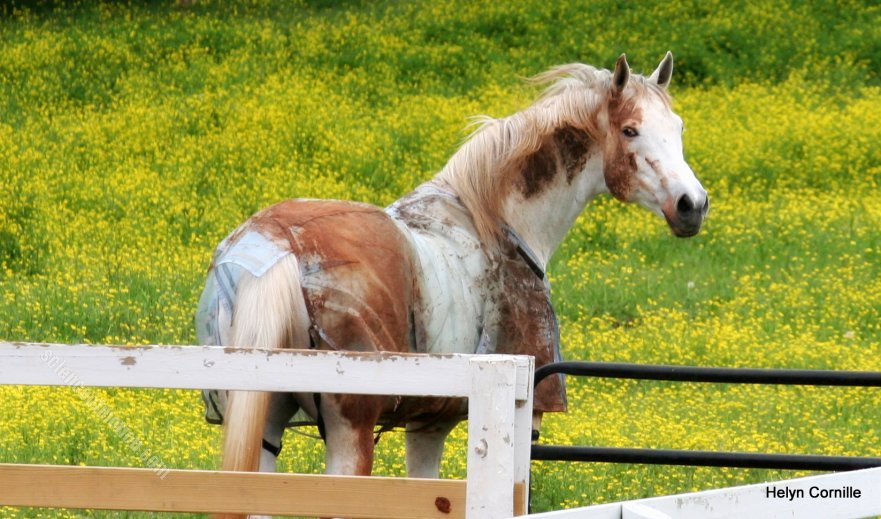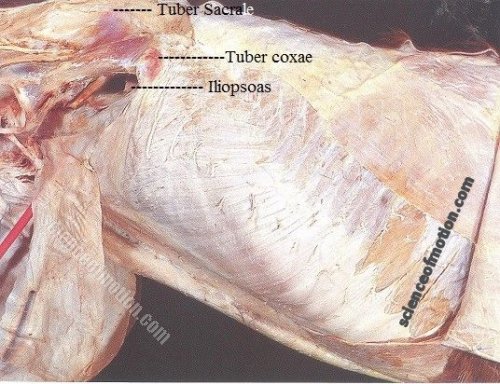Psoas
Chazot Thoughts 42
Psoas
Chazot
“We are being sold products and social scenarios that appeal to our fantasies but ultimately fail us.” (Fred Ritchin),
He smiled reading the quote thinking, “This applies to the horse world. All these ‘release’ theories, including releasing the psoas, appeal to riders’ fantasies but ultimately fail the horses.” I cannot agree more with him. Releasing our muscle tone ultimately increases our muscle work in locomotion. Most of the musculotendinous length change that is part of our work during steady-speed locomotion, is not executed by our muscle fibers but instead, by elastic recoil of our associated tendons and muscle aponeurosis. The spring capacities of our tendons is particularly useful in cursorial locomotion as they facilitate the exchange of kinetic, potential and elastic strain energy, and reduce the amount of mechanical work that our muscles have to perform in order to move our legs. This is the fundamental principle of our locomotion.
It looks at this point of my mental demonstration that the theories such as psoas or myofascial release would fit our locomotor patterns. This is a scenario that might appeals to one’s fantasies but does not appeal to our muscular and neuromuscular system. There is no doubt that in case of overloading and consequent muscle spasm, these techniques might be helpful. They became a problem for us when they are used indiscriminately or in preparation to our work. Even if the long tendons of our lower legs are doing most of the work swinging our limbs forward, the elastic strain energy that is stored in our long tendons during the time our limbs are on the ground, relies on the capacity of our muscles to which our tendons are attached to optimize the elastic strain energy by ensuring proper tension of our tendons. Any manipulation releasing these muscles hampers the capacity of our tendons to store adequate elastic strain energy and consequently alter efficient locomotion.
These theories are dangerous because they are well packaged but they are simplistic. They describe very well the direct muscular effect but consciously or unconsciously ignore our fundamental principles of locomotion. Let talk about our hind legs for instance. When the tendons of our hind legs do not store enough elastic strain energy during the stance, we have to compensate the lack of elastic strain energy with greater muscle work. This of course alters the swing phase of our limbs and often results to early impact of our hind limb. Then, another set of kinematics and dynamic abnormalities occur. Our hock is composed of four joints which, on the top of flexing and extending, execute inward rotations, medial to lateral during one sequence of the stride and lateral to medial during the next sequence. Our soundness demands that all these complex movements are perfectly synchronized. Early impact of one hind limb creates a situation referred to as “functional straight hock” inducing aberrant stress and consequently arthritis between Mt3 and T3. Then, the vet has to come injecting our hocks. A more efficient approach would be creating first proper locomotor patterns and if muscle spasm occurs in the process, have a therapist releasing the spasms. I know that he thinks in those terms. We never have muscle spasms because he is so advanced in his rehabilitating approach that he cans resolve every problem through motion. However, I heard him saying to trainers, “In the process, you might not always be able to avoid muscular overloading and consequent spasms and you will have to work with your therapist.”
The problem is that the type of chain reaction described above might or might not happen as we have many ways to compensate. This allows the ones who believe in these releasing theories to defend their belief because they have deal so far with horses which successfully compensated for their misconceptions. Other horses are less lucky. It is not that these horses are less intelligent. It is simply that they come in life with less strength or even a weak region of their body, or muscle or tendon, or morphological flaw, and their compensations lead to pathological changes. Some of these horses come here. Manchester was probably born with a weak left stifle and his left stifle is the joint that paid the price. Caesar was trained with excessive weight on the front legs and arthritis developed on the junction of PII and his coffin bone on the right side. They both went through these releasing theories. The ones who believe in these superficial theories feel that they have helped my two friends when in fact they have aggravated underlying problems. How do I know that, simply because it is by addressing these underlying factors that he restored soundness. However, they are sound as long as they are trained the proper way. Due to the intensity of his schedule, he had to let Caesar on the side and I saw the return of abnormal kinematics watching Caesar in the field. I am glad that he was next to me watching Caesar and thinking, “I have to put him back to work.”
Reading the comments about a series of pictures that he published questioning the claim of “releasing the psoas,” he was amazed by the fact that while the techniques applied to release the psoas were well explained, not one addressed the fundamental question, the purpose of releasing the psoas. He asked the question, “Since the psoas is part of the lumbar spine stabilization mechanism, why would you release the psoas.” The responses were “drowning the fish.” Drowning the fish is a French expression referring to answers that are not real answers. They are confusing the subject or jumping to another subject because truly they don’t have the answer. It was statements such as, “I believe that releasing the psoas can help enhancing the horse gaits, performances and soundness.” 
 These are just subjective statements; they are catch phrases that do not resist serious analysis. The second type of responses was in reference to humans. “I had my psoas released because I was in pain.” I look at him and he is a vertical creature. He looks at me and I am a horizontal creature. His psoas and my psoas are set totally differently. They are under very different stresses. His psoas can eventually be reached through manipulations. Mines, is another story. Through his studies and responses to his studies I see quite often these references to human bodies. I did not discuss about that with him but my thoughts are that we are functioning very differently and we are subjected to very different stresses. I was glad when I picked his thought on the matter. He was reading one of these responses thinking, “When peoples cannot truly explain their beliefs in respect of equine physiology, they refer to human physiology.”
These are just subjective statements; they are catch phrases that do not resist serious analysis. The second type of responses was in reference to humans. “I had my psoas released because I was in pain.” I look at him and he is a vertical creature. He looks at me and I am a horizontal creature. His psoas and my psoas are set totally differently. They are under very different stresses. His psoas can eventually be reached through manipulations. Mines, is another story. Through his studies and responses to his studies I see quite often these references to human bodies. I did not discuss about that with him but my thoughts are that we are functioning very differently and we are subjected to very different stresses. I was glad when I picked his thought on the matter. He was reading one of these responses thinking, “When peoples cannot truly explain their beliefs in respect of equine physiology, they refer to human physiology.”
In fact, our psoas is not very large. Our gluteus medius, biceps femoris but also to a lesser extent, our semimembranous, semitendious and adductor muscles are quite large. The reason why we do not need a large psoas is that the protraction of our hind limb is initiated at the end of the stance via active shortening of our hip flexor muscles but maintained through swing via passive recoil of elastic structures such as the aponeurosis of the tensor facia lata and the peroneus tercius and flexor digitalis superficialis, which are part of our reciprocal apparatus . Truly, when I move I do not really know which muscles I contract. I know the description because I followed his mind as he was reading a study. In fact, what I just say should be in italics as it is almost word for word what R.C. Payne, J. R. Hutchinson, J. J. Ronilliard, N. C. Smith and A. M. Wilson wrote in their study, “Functional specialization of pelvic limb anatomy in horses”, (J Anat. 2005, 206, pp557-574)
Our psoas does engage our hind legs but as part of an overall network involving muscles, tendons and aponeurosis. This is why our psoas is not as large as our biceps femoris and other muscles involved in propulsion. This is also why attributing rounder holding of our lumbar region to tightness of our psoas is, very often, a short cut based on simple anatomy but ignorance of dynamics involved in our locomotion.
Another point that surprised him deeply with the comments was a complete lack of concern for the concept of stability. Our psoas is part of the muscles ensuring the stability of our lumbar region and lumbo-sacrale junction. He responded to comments underlining the problem of stability and was surprised that such major concept was totally dismissed by his opponents. They further their descriptions of how they release the psoas but the concern for stability was totally ignored. I share his concern. Stability is a major part of efficient locomotion, performances and soundness. In fact, down to details, we are designed with the souci of stability. For example, the architecture of our hind legs’ superficial digital flexor muscles is useful for generating large forces while allowing our tendons to undergo extension, storing elastic energy that can be released later in the stride. Our superficial digital flexor muscles also function in attenuating the high-frequency and potentially damaging vibrations to which our apparatus is submitted during locomotion. Due to similarities in their architectures, it is also likely that the flexor digitorium lateralis head of our flexor digitalis profondus functions in a similar way damping the high intensity vibrations induced in our apparatus during locomotion. Do I want anyone releasing these muscles before my work? Absolutely not.
Chazot
12/2014
Learn about our IHTC in hand course















